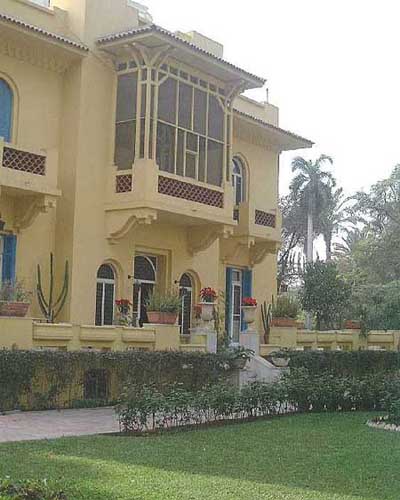

Villa Mizrahi, Ambassador Hector Cardenas
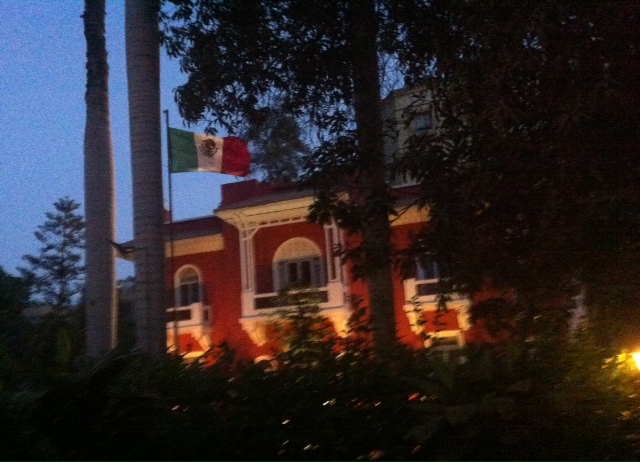
|
|
|
|
|
|
EGY.COM - JUDAICA
|
|
By Samir Raafat,
December 1997
On account of its mango color and Hispanic inhabitants, Maadi's regulars call it Casa Manga. They are referring to the residence of senor Hector Cardenas, the incumbent Mexican Ambassador to Egypt. Both Hector and his wife Martha Suarez are consummate artists. He is into painting with several exhibitions to his name and la senora Cardenas is into flower arrangements some of which have been immortalized on canvass by her husband.


Villa Mizrahi, Ambassador Hector Cardenas

Flowers were never wanting in Maadi's largest patch of green. And lest anyone think this unique three-acre garden of hesperides is Cardenas's doing, suffice to say it existed long before Egypt established relations with the United States of Mexico back in 1961.
Casa Manga and its three identical contiguous siblings were built in the late 1920s by lawyer Emanuel Mizrahi. One house was for himself and his piano-playing wife Leah Assayas, and one each for his son George and daughter Lydia. No one knew for whom the fourth house was destined, but as it turned out, it was leased out to Princess Ulfet Fazil, a divorced Egyptian princess who lived there with her Russian lady in waiting, Madame Schallenberg, until they both expired in the 1960s.
George A. Mizrahi (later spelt Misrahy) never occupied his house preferring to relocate in the United States with his young bride Nimet Cattaui. His sister Lydia on the other hand married accountant-mathematician Raoul Farahat. Henceforth her house on Road 18 became a giant art studio. Lydia had studied art under French master André Lhote and later under Maadi's homegrown Swiss artist, Margo Veillon. Most art study-sessions took place in a delightful gingerbread-like studio tucked away at the far end of Mizrahi's beloved garden.
The stone-built studio was also where Lydia took refuge. The fair rebel spent many hours therein with her pet monkey Manolli and her avant-garde friends none of whom met with her dominant father's approval.
A friend who was the son of a rich Jewish financier had visions of painting Egypt's entire political scene red. In fact, Henri D. Curiel was the unofficial architect of Egyptian communism. Years later he lent his support to the bloody Algerian War of Independence. Later, he donated his family mansion on Zamalek's Hassan Sabri Street to serve as Algeria's embassy to Egypt.
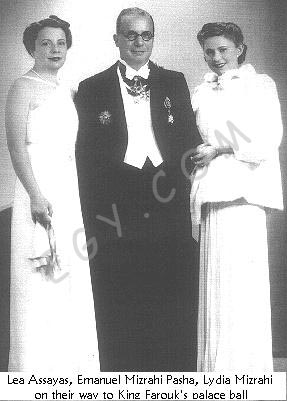
Another one of Lydia's friends was the Syrian Père Ayrout whose contractor papa worked for Baron Edward Empain and helped build Heliopolis. Preaching love and compassion the prodigal son took to traveling by donkey around Upper Egypt's underprivileged countryside. Lydia accompanied the Born-Again preacher on one or two of these neo-biblical wanderings.
Another infrequent visitor was the much older Hassan Fathi, father of Egypt's revival architecture. His dream was to paintbrush Egypt's rural landscape with arches and dome-topped mud-brick houses. He called it the 'architecture of the poor'. A living testimonial to his visions exists today in New Mexico.
The members of Lydia's inter-denominational coterie knew what they wanted. But whatever their purpose and motives, all were inspired at one time or another by the Mizrahi garden.
Emanuel Mizrahi, whose origins can be found in Istanbul, was a hard-working self-made man. His Cairo law firm Mizrahi & Rosetti (originally Pezzi & Rosetti) was one of the best, which is probably why it was handpicked by King Fouad to handle all matters concerning the khasa malakia--royal privy estates. Not surprising therefore when Mizrahi received the honorary title of 'pasha' by separate decree in February 1940. If anything, the act of royal recognition would make Emanuel Mizrahi the last Jewish pasha in history!
But long before he earned this unique distinction, Mizrahi Pasha made local history some other more colorful way. When he was not working, Mizrahi Pasha's attention focused entirely on his garden. Amongst his horticultural treasures was the leading cactus collection this side of the Atlantic. Even Crown Prince Mohammed-Ali Tewfik, whose own garden in Manial Palace was second to none, visited Maadi for the singular purpose of plucking a cactus sapling from the Mizrahi nursery.
Other habitués included the chief gardeners of Zohria's Jardin des Plantes. Which is how these gentlemen discovered the Bird of Paradise, introduced into Egypt by Mizrahi Pasha when he accepted payment in kind from a South African client.
There were also Mizrahi Pasha's wonderful royal palms, those grand white-trunked splendors adorning the front lawn of Casa Manga. What exactly did the pasha have in mind when he landscaped this section of his garden, planting his palms in an unintelligible yet symmetric formation. Was this some freemason sign for the benefit of the skies or was it a simulation of Britain's Stonehenge? We can only speculate.
Beyond Mizrahi's royal palms everything becomes clearer. The pastoral well, the quaint gazebos, the fishpond, the cluster of tropical trees, the wartime shelter hidden under an overgrowth of African weeds, and the exotic plants from distant Indian Ocean islands. All are set in a festival of colors punctuated by beds of roses where each one of these scented flowers is identically different from the other.
As he grew older, Mizrahi's legs gave way making it difficult for him to make his garden rounds. Bent on attending to his floral beauties, the pasha buckled himself in his favorite chair and, fly-swish in hand, had his two trusted servants carry him around like they would an African chieftain.
But in the end the pasha had to let go when his health took a turning for the worse. Medical attention being sought in France it was the ultimate parting with his floral trophies in 1961.
Lydia and her family followed him into involuntary exile in the Summer of '63.
During Nasser's regime of terror bent on breaking up the social register, Mizrahi's four villas were sequestered on account of his son-in-law Raoul Farahat. Was it because Farahat was a partner in the British accounting firm of Russel & Co. No one knows to this day. But it is thanks to some eleventh hour maneuvering by Lydia that her father's house and garden were saved from the clutches of an uncompromising state gone madly socialist. The silver lining was that Jorge Castaneda de la Rosa (1921-97) and his wife Naomi Guttman-Rozental had already fallen in love with the place. A feeling later shared by the latter's two sons Andres Rozental and Jorge Castaneda Jr

Ambassador Jorge Castaneda presenting his credentials to President Gamal Abdel Nasser in 1962
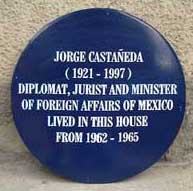

Mexico's second ambassador to Egypt was scouting for a house in Maadi just about when Nasser decided to de-privatize the country stripping it of its private wealth. Whether it was Mizrahi Pasha's Yucatan cacti that did the trick or Ambassador Castaneda de la Rosa fell in love with the garden's unique roses, in either case Villa Mizrahi was leased out in 1962 to the government of Mexico for a ridiculous nominal one-digit sum. Since that day, Casa Manga has been under that country's protection.
Mizrahi's three other villas were not as fortunate. Two were purchased under dubious circumstances and illegally pulled down in 1994 to make way for three high rises. The third--which is thankfully still there leased out to the Swiss consul-general--was seized in the late 1960s by a rapacious female member of Nasser's rubber stamp parliament. Once installed, the "honorable" MP promptly built an unsavory building in the villa's front yard. No one dared contest the validity of her title and deed. The reign of terror was in full bloom. Maadi's villas and their occupants were the first to suffer.
Meanwhile, at Casa Manga, depending on the Mexican ambassador in residence, Maadi's largest garden vacillated between kaleidoscopic Springs and discordant Autumns. Fortunately, this villa was blessed with pro Spring incumbents since 1995. The rest of Maadi was less fortunate as apartment and office buildings continued to replace villas. So the fear remains: Should the Mexicans one day abandon Casa Manga, Mizrahi's flowery legacy will surely disappear and all we will be left with are Ambassador Cardenas floral paintings.
Via con Dios …
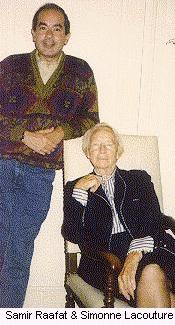
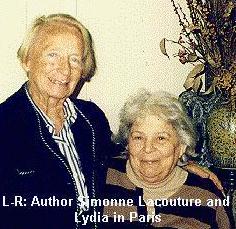
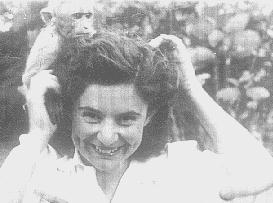


- As a schoolboy I discovered the wonders of Villa Mizrahi during the birthdays (December 19) of Mizrahi Pasha's granddaughter Inji Farahat who was in class with me at the Maadi English School. Little did I realize then I would revisit the villa in adulthood during Mexican embassy national day celebrations and other diplomatic functions.
- I visited Lydia Mizrahi at her rustic Rue du Dragon duplex in Paris in October 1992 and again in May 1998. Her daughter, Inji Farat-Lew, lives in Martha's Vineyard, New England, with her husband Jason (MD) and three daughters: Olivia, Isabelle and Sophie.
- Lydia' s son Jean, lived in France with his wife and their two kids. (He died in the early 2000s).
- Remarried to an American Lydia's brother George became a scientific researcher and a distinguished member of the American Physiological Society. A NIH Career Investigator George A. Misrahy helped found the Deafness Research Lab which later became the Sensory and Developmental Physiology Research Lab at Hollywood Children's Hospital in Cailfornia. According to his sister, George died in the United States in 1963 (or 1964) following an alleged lab infection sustained when he was experimenting with vaccines. He was survived by four daughters.
- A widow since 1988, Lydia is in litigation with those who squatted and/or usurped her Maadi property. She is also contesting the fact that the property she inherited from her mother--in whose name the four villas were--was actually sequestrable.
- Following in Ambassador Castaneda footsteps, his son Jorge Jr. was appointed mexico's Minister of Foreign Affairs (during the presidency of Vincente Fox). Simialrly, Andre Rozental represented his country at the Court of St James...
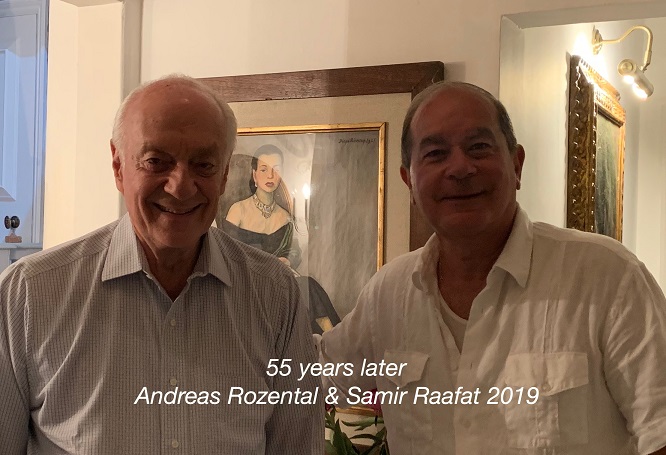
|
|
|
|